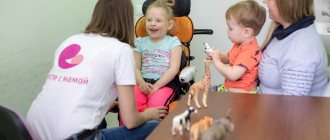Types of speech therapy classes for children
Speech development classes may consist of:
- finger games;
- articulatory gymnastics;
- games for onomatopoeia, hearing development, logorhythmics (poetry with movements);
- poems for replenishing vocabulary, speech development.
Speech therapy classes should be conducted daily. The most difficult thing about them is to be able to interest the child. Therefore, it is not at all necessary that such classes be conducted like lessons at school, where students humbly sit at their desks and the teacher explains a new topic in a monotone voice. For kids, such activities are akin to torture. Turn on your imagination: let your baby learn with you, playing on the rug, sitting on a pillow, hiding in his hut, jumping or running... The main thing is the final result. Build your lessons in a playful way - this way your child will remember the material better and won’t get tired at all.
In addition, when arranging speech therapy classes with your child at home, you should:
- Start classes with 2-3 minutes, gradually increasing their duration to 15-20 minutes.
- Make classes interesting so that the child has a desire to study. Never force your child to do exercises - you will get the opposite result.
- Perform tasks more often, but let them be short-term.
- Treat your child’s failures easily, without shouting, with understanding. Analyze each situation together, for example, look for the reason why the child has such a naughty tongue, and how to fix it.
Now let's look at each of the types of speech therapy games listed above.
Finger games
Through finger games, a child's fine motor skills develop. How does this help speech development? Scientists have found that there is a close relationship between the human hand and the part of the brain that is responsible for speech. Therefore, by learning texts using finger exercises, the child develops spatial thinking, imagination, reaction speed, attention and emotional expressiveness. Memorizing texts occurs faster, and speech becomes more expressive.
The effectiveness of finger games is achieved if you work with your child daily, devoting only 5 minutes to such exercises. Let's look at a few examples of finger games.
- "Flower". Fingers pointing up, gathered together. We make a bud from half-bent palms, pressing them together. We begin to pronounce the quatrain, performing movements on every second line:
The sun is rising -The bud is blooming! (spread the fingers of both hands to the sides, keeping the lower part of the palms together)
The sun is setting -
The flower goes to bed! (return to the starting position).
- "Kitty." Place your palms on the table and clench them into fists. To the words “Fist - palm. “I’m walking like a cat,” we simultaneously straighten our fingers, without lifting the handles from the surface of the table, and squeeze them. To complicate the exercise, unclench your palms alternately on the count of “one, two.” You need to repeat the exercise 3-5 times.
- "The bird is flying." Cross your arms with your palms in front of you. Interlace your thumbs together to imitate the head of a bird. The remaining fingers are wings that will need to be flapped without separating the fingers.
The birds have flown (flapping their wings)We sat down and sat, (press our palms to our chests)
Then we flew.
- "Maple". This game is suitable for children 3 years of age. All movements are performed in accordance with the text of the poem:
The wind quietly shakes the maple tree, (spread your fingers and pull them up)Tilts to the right, to the left: (swing your palms to the right and left)
One – tilt and two – tilt, (tilt your palms as low as possible in the indicated directions)
The maple leaves rustled. (we move our fingers quickly)
- "Cake". We perform movements according to the text of a poetic work.
We remember the dough with our hands (squeeze and unclench your fingers several times)We will bake a sweet cake. (think imaginary dough)
Lubricate the middle with jam (make circular movements with your palms on the table surface)
And the top with delicious cream (with three palms touching each other in a circular motion)
And coconut crumbs
We will decorate the cake a little (we imitate the action with both hands)
And then we’ll make tea -
Invite a friend to visit! (we shake our left hand with our right hand).
- "Winter". Suitable for children 4-7 years old.
One, two, three, four, five, (fingers bend one at a time)We went out into the yard for a walk.
We sculpted a snow grandmother (we perform the movement of sculpting snowballs)
The birds were fed grains (we throw grains, rubbing our fingers together)
After we rode down the hill, (we run the palm of our right hand over our left palm)
They were happily lying around in the snow. (we alternately place the pens on the table surface, either with our palms or with our backs)
We came home in the snow, (shake off the snow from our palms)
We ate borscht and went to bed. (we make movements with a spoon and pretend to be asleep by folding our hands, palms to palms, and placing them under our cheeks)
Finger games can be used as physical education during speech therapy classes. They help to change the type of activity without losing children's attention and desire to learn. In addition, it is interesting, fun and useful. The main thing is to tell the poems with exciting expression and clearly show the movements.
In addition, finger games help:
- develop coordination of movements of both arms of the child;
- combine the child’s speech and physical activities, use them simultaneously;
- develop precise and differentiated movements of children’s fingers and hands;
- learn to repeat the movements of adults;
- become more attentive, develop visual perception;
- improve memory, imagination, perseverance.
Finger games need to be done systematically. Classes are possible with one child or with a group of children. However, it is important to take into account the age of the children, their mood, readiness for classes, desire and opportunity.
Articulation gymnastics
You can find the presentation and musical accompaniment for articulatory gymnastics on this page.
Articulatory gymnastics is necessary for correct sound pronunciation, strengthening the muscles of the face, tongue, lips, and soft palate. There are many exercises, a specialist will help you choose the most suitable ones for your sounds.
Tasks are divided into static and dynamic. Each has a name that your baby can easily remember, which will make it much easier to understand the instructions during class. Using a little imagination, you can go on fabulous trips with your child, where the main character will be the child’s tongue. There are many variations, it all depends on you. Below are the same exercises; after reading the descriptions, you will understand that they are not complicated and do not require additional knowledge from you (parents).
Articulatory gymnastics is a group of exercises for the tongue and lips. They are the main ones in the process of sound pronunciation. If the tongue is not developed enough, a person will not be able to pronounce sounds, which means that his speech will be incomprehensible or not clear enough.
They perform articulatory gymnastics in front of a mirror - this way you can see the correct movements of the tongue and lips during exercise. It is very important for children to see how his tongue and lips move, how and where they are located. This way, understanding of their correct location quickly comes, on which the effectiveness of articulatory gymnastics depends. Speech therapists recommend doing the exercises twice a day for 5-7 minutes. As a result, your child will receive correct and clear speech.
Let's look at a few simple but effective exercises.
- "Smile." Stretch your lips strongly in a smile, but your teeth should not be visible. Hold a smile for 30 seconds.
- "Fence". Smile hard so that your teeth are visible, hold the smile.
- “Let’s punish the naughty tongue.” Open your mouth slightly, place your tongue on your lower lip and, slapping it with your lips, pronounce “five-five-five...”.
- "Tube". Open your mouth, stick out your tongue and try to bend its side edges upward in the form of a tube, hold it in this position for 30 seconds.
- “Let’s lick the jam.” Slowly, without lifting the tongue, first lick the upper lip from corner to corner, then repeat the procedure with the lower lip.
- “The clock is tick-tock.” Make a smile, open your mouth slightly, then use the tip of your tongue to touch the corners of your mouth one by one.
- “Brushing our teeth.” Smile, open your mouth slightly, then with the tip of your tongue, pressing it hard enough, brush the inside of the teeth of the lower row (7-10 times). Repeat the same exercise with the teeth of the upper row (7-10 times).
- "Swing". Smile and open your mouth wide. Then lower the tip of the tongue behind the bottom row of teeth by “one”, and lift it by the top row by “two”. Repeat – 4-5 times.
- "Snake". Open your mouth, stick out the narrow part of your tongue from your mouth and quickly hide it back. Touching teeth and lips is prohibited.
- "Rent a pencil." Place a pencil on the table in front of the child. Ask him to smile, place the wide front part of the tongue on the lower lip and, slowly (exhaling air), blow on the pencil so that it rolls along the surface.
In addition to articulatory gymnastics, exercises are used aimed at developing the voice, breathing, and speech hearing. In this complex, classes will allow the child to develop correct sound pronunciation.
Logorhythmics, hearing development and onomatopoeia
Phonemic hearing (also called speech hearing) is the ability to distinguish, understand and produce sounds. With insufficient development of speech hearing, the perception of what is heard is distorted, and accordingly, speech is produced incorrectly and unclearly. To correct or prevent the development of this problem, the following exercises are performed with children:
- “Listen Ears” is a game for developing hearing. The goal is to improve auditory attention and strengthen the ability to distinguish sounds. The adult shows the child several different objects that can make sounds - spoons, drums, glasses, rattles, maracas, etc. Together with your baby, you need to listen to how objects sound. Then the adult asks the child to turn away and guess what object will sound behind him.
- “Where is it ringing?” - an exercise to develop hearing. To play you will need a bell and a spacious room. The child stands with his eyes closed, while the adult quietly moves around the room, ringing the bell in different places. The child’s task is to point with his hand where the bell rang without turning around.
- Onomatopoeia games: in principle, any children’s story-based picture is suitable for this exercise. For example, in the picture a girl is rocking a doll: “Oksana puts the doll Masha to sleep and says ah-ah. Let's help her together! A-a-a!” Help your child, use movements that imitate rocking a baby, control your baby's articulation.
- Exercises to imitate the voices of birds and animals. To make such games more interesting, it is recommended to use pictures or figures of animals and their babies as visual material. For example, the game "Komarik". For this you will need an image of a mosquito. The adult says: “Meet this mosquito’s name Stepan. When he flies, he likes to sing the song z-z-z. Can you sing this song? Let's try it together with Stepan! Z-z-z.” Then we invite the child to catch the “mosquito” in his fist and listen to his song. We grab the air with our fist, bring it to our ear and pronounce: z-z-z. Next, we invite the child to also catch the “mosquito” and listen to its song. You can imitate everyday noises: scissors cutting - chick-chick, water dripping - drip-drip, etc.
- Logorhythmics are speech therapy exercises that combine movements, speech and music. Children really like this type of activity - they find it fun and interesting. First, the adult reads the poem and shows the movements, all of which is accompanied by skillfully selected music. Then the children repeat everything themselves or with an adult - it couldn’t be simpler. The main thing is to prepare thoroughly in advance. For example, the game "Walk".
Along a narrow path (we walk in place)Our legs walked (we walk, raising our legs high)
Over the pebbles, over the pebbles (we slowly shift from foot to foot)
And into the hole... bang! (jump and sit on the floor)
Poems for replenishing vocabulary, speech development
You can download poems and exercises for them here.
Tongue twisters are great for speech development - these are small rhyming phrases. With their help, speech becomes clear and correctly correct, they increase the child’s vocabulary, improve speech hearing, and improve diction.
- The beavers go into the cheese forests,
Beavers are kind, beavers are kind.
- Dali along with curdled milk
Our Klasha porridge.
Ate-ate porridge Klasha
Along with curdled milk.
- Six little mice rustle in the reeds.
- Sasha knocked off the cones with his hat,
I got a bruise on my forehead.
- Mama washed Mila with soap,
Mila didn't like soap.
There are many such tongue twisters; you can find them in specialized literature for children. You shouldn’t immediately learn complex poems with your child - start small. And remember: the child knows and understands much more words than he pronounces; they are simply, so to speak, “in sleep mode.” And for the baby to start using these words in communication, you need to help him. And this can be done by constantly studying with him, reading books to the child, looking at pictures with him, commenting on what he saw or heard. Help your child become an erudite person with beautiful diction and competent speech. And then a successful and happy life will be guaranteed to him.




